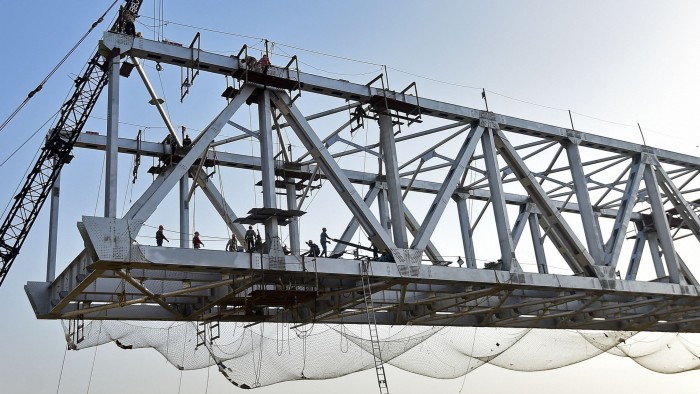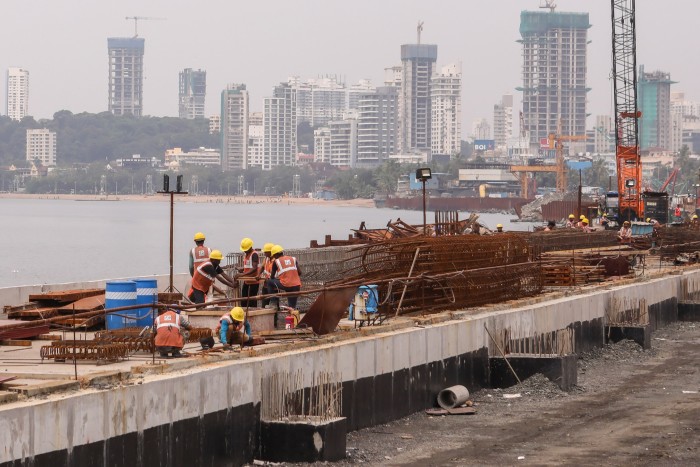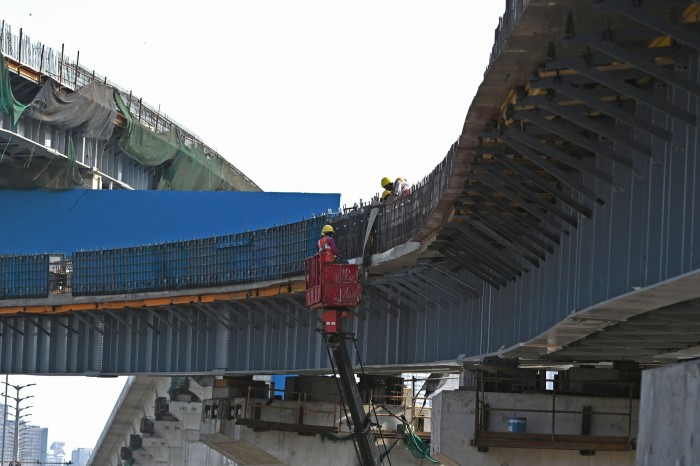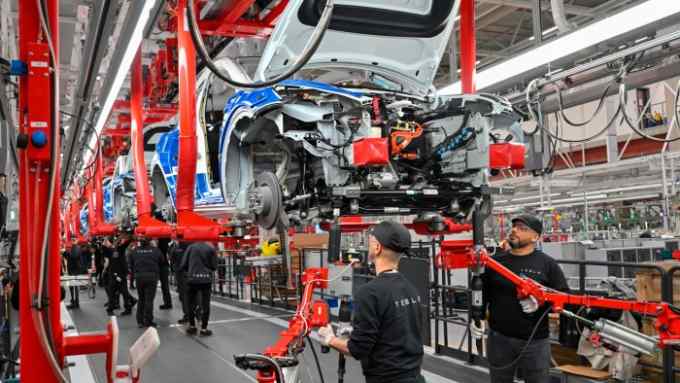India’s infrastructure boom poses steel and cement emissions challenge

Simply sign up to the Indian business & finance myFT Digest -- delivered directly to your inbox.
India’s steel and cement sectors are expanding rapidly as the government pours money into infrastructure, ahead of elections next year. But New Delhi does not have a comprehensive road map to curb carbon dioxide emissions in these sectors, experts warn, despite the Asian economic powerhouse setting a target of net zero by 2070.
“As India has decided to decarbonise by 2070, at some point in time . . . there has to be a regulatory architecture which pushes these sectors into decarbonisation,” argues Saurabh Kumar, a former civil servant in India’s Bureau of Energy Efficiency. He now heads the Global Energy Alliance for People and Planet in India, which is part funded by Jeff Bezos’s Earth Fund and the Rockefeller Foundation.
Steel and cement are known as “hard to abate” sectors, because reducing the amount of fossil fuel energy they use, and the CO₂ emissions that their production processes create, is difficult.
However, with India’s cities growing at speed and energy consumption projected to rocket as industrialisation and consumption ramp up, New Delhi is under international pressure to keep emissions down. It is already a huge energy consumer because of its 1.4bn population — the world’s largest — although its per capita emissions are less than half of the global average, according to the International Energy Agency (IEA).
“[The] first, most important step is to recognise that the transition is already under way — and then to step up ambition and not be in denial,” says Yash Kashyap, a senior analyst at advisory organisation the Climate Policy Initiative in New Delhi who has researched India’s decarbonisation policy for steel and cement. “A few companies are already doing that, irrespective of the presence of supportive policies.”
Cement and steel account for 15-20 per cent of India’s emissions, according to Kashyap’s most recent research, and are more than 90 per cent dependent on fossil fuels. A German government-funded study in 2020 projected that India’s steel and cement sectors will “surpass the climate impact of the electricity sector” as demand for the materials rises with infrastructure development.
Currently, Indian steel and cement making both depend on coal — the country’s main domestic source of non-renewable energy. But India’s cement industry compares favourably on emissions with peers such as China, thanks to an industry-wide energy efficiency drive: its total emissions per tonne of production are about 15 per cent lower than its Asian rival, according to the IEA.
Even so, experts say that, if India is to curb cement and steel-related emissions, it will eventually need to replace coal-generated energy with cleaner, renewable alternatives, use less emissions intensive processes, and introduce carbon capture technologies. Obligatory carbon trading will also be crucial in driving these changes, they add.
Under the Bureau of Energy Efficiency, India has successfully used a market-based scheme to encourage companies to bring down their energy use. It also now has the option of introducing compulsory carbon trading, after an amendment to its Energy Conservation Act last year empowered the government to issue carbon credits.

However, policymakers appear reluctant to go so far. “What’s being talked about is a voluntary carbon market,” says Kumar. “Good carbon markets really are compliance markets . . . When you get the regulations, [and] the decarbonisation targets to industry, that is when you will have a fully functional domestic carbon market.”
Meanwhile, the steel industry’s coal-fired blast furnaces are at particular risk of becoming stranded assets.
This could be avoided by retrofitting carbon capture technology, says Atanu Mukherjee, chief executive at MN Dastur & Co, a Kolkata-based engineering group. Dastur worked with the Indian government to publish a carbon capture, utilisation and storage policy framework last year.
There are plenty more hurdles to overcome, though. Solar-powered hydrogen production, while promising in terms of energy density and emissions, is a long way off being economically viable for use at scale. Similarly, carbon capture technologies are expensive and unproven at scale.
Many governments have offered industry grants and subsidies. In the US, for example, President Joe Biden’s Inflation Reduction Act offers tax credits for clean hydrogen and carbon capture, both of which could benefit steelmakers. Yet India’s industrialists complain that they do not have the same support, and the government has not given deadlines for hitting emissions-related targets.

“Right now, there is no incentive for us to do [carbon capture]”, says Sajjan Jindal, managing director of JSW Steel, one of India’s biggest private sector steelmakers. While his companies’ investments in increasing energy efficiency bring down costs and boost returns, carbon capture is “very expensive, so it’s not so simple”.
“It will depend on the government’s policy,” Jindal says. “[If it were] to say, ‘OK, you have to stop it by this time, otherwise you will not be allowed to operate the business,’ for example, that would force us to do it, no matter what the cost.”
Regulations in India’s steel export markets may force the issue. The EU’s flagship carbon border adjustment mechanism, for example, which will start being phased in from October, is an import levy intended to discourage emissions-intensive manufacturers shifting production to countries with looser climate regulations — so-called “carbon leakage”.
“If we want to export into Europe, they will tax us because our steel is not green steel,” says Jindal, arguing that this is “unfair” under World Trade Organization norms.
“Our government does not give us any grants,” he notes. “In Germany, in Spain, in France, huge monies have been given to steel companies.”

Comments